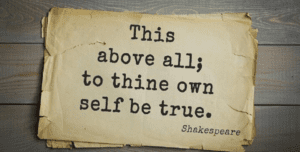
We have become very polarized. Our country, as a nation, has become separated through divergent conversations, dialogues and opinions more so than ever before. It seems to have been heading in that direction for some time and the emergent participation in social media and less traditional news outlets have raised the volume on, and exacerbated, our differences. It’s actually gone beyond having different points of view ~ we have begun to dislike and isolate ourselves from those who disagree with us. We’ve become so divided that we’ve lost our ability to discuss, debate and argue in a dignified way. It seems that we can no longer have differing points of view without it quickly spiraling into personal attacks and becoming offensive toward one another. I call this phenomenon “The Either/Or Syndrome”. How this translates as a practical matter is, “it’s either my way (which is right), or it’s your way (which is wrong)” and there’s no room for anything else. We no longer look to find common ground and discover what about what the other person’s thinking may be, and whether or not it has value for consideration. It’s take it or leave it, and if you leave it, you’re an idiot and I’ll let you know that, too. We have become unsophisticated, awkward, mean and sometimes vulgar with one another with whom we disagree.
Disagreement and debate are at the foundation and traditions of our culture. It’s what has allowed this country to grow and thrive and keep itself in check for centuries. Yet that very quickly is disintegrating right before our eyes. President Bill Clinton shared a snippet from a book he read called “The Big Sort” in which he pointed to this dilemma for us as a nation. He says:
“I read a book a couple of years ago that I recommend to people all the time called “The Big Sort” by Bill Bishop who is a journalist and as it happens a pretty progressive Democrat from Austin, TX. And what provoked him to write this book was his neighborhood in Austin lost its only Republican neighbor. And he loved this guy. And he talked about how their kids played together, and they took walks together. And how much he learned from their arguments, because they didn’t see everything the same way and how much it meant to him to know there was somebody he liked and respected and cared for that he could actually have an honest discussion where neither one of them would be completely predictable. But, he said, I was the only one of our neighbors who was nice to him.
Now in their neighborhood in the 2004 presidential election Senator Kerry defeated Pres Bush 3–1. So the republican guy moves out and moves into another neighborhood in Austin, TX where President Bush defeated Senator Kerry 4–1. And Bishop said, you know both of our neighborhoods were poorer for that. He pointed out that in 1976 when Jimmy Carter and Gerald Ford had a razor thin election, which by the way, ultimately culminated in a lifetime friendship between the two of them and lasted until President Ford passed away. But anyway, in that election ~ a 1% election ~ only 20% of America’s counties voted for one or the other of them by 20% or more. Which meant that in 1976, you could go into any coffee shop or hair salon or barber shop or bowling alley and have a conversation with people who didn’t necessarily disagree with you about what was going on in America. By 2004, when President Bush won the closest re-election margin of any President since Woodrow Wilson in 1916, 48% of our counties voted for one or the other of them by more than 20%. That much movement.
So he said you know America’s making real progress, this Bishop guy said, we’re not as racist as we used to be, we’re not as sexist as we used to be, we’re not as homophobic as we used to be. The only bigotry we have left is that we just don’t want to be around anyone who disagrees with us.”
The link https://youtu.be/5rjOSfYc5yA
My guess is that you’ve experienced what Clinton is referring to. We don’t talk and discuss anymore. We speak and don’t listen. And somewhere in all that we miss the opportunity to discover our amazing ability to come to an agreement that’s workable for everyone. It’s as though we’ve taken on a childish style, “if I don’t get my way then I gotta’ make sure you don’t get yours.”
Everyone is familiar with the biblical story of King Solomon and the two women who had a baby and couldn’t decide who the baby belonged to. The King, in frustration offered his solution and told them they would just split the baby in half and share it. It was his way of showing them the absurdity of not being able to work it out or come to some acceptable solution. It seems that we are unwilling to consider any alternative other than “I’m right”.
The solution to this, for us, lives in our ability to have a conversation in which we consider the other’s point of view as valid. Not right or wrong, just valid. In fact, just as valid as our point of view. And from there to begin to see what’s possible in a dialogue that is focused on what’s possible as the end result. Right now our elected officials sit at a cool 15% approval rating mostly because they don’t seem to get anything done and this is because they disagree and won’t have the tough discussions that need to be had to get to a place where they can agree. So the conversation shuts down, and just like children they take their marbles and go home. We can’t let it be resolved as Bill Bishop, author of “The Big Sort” said, “The only bigotry we have left is that we just don’t want to be around anyone who disagrees with us.” It must start with each of us taking a stand to transform the conversation and return to civility.
Read More
Without authenticity you can forget being an effective leader. Sound extreme? Over the last decade authenticity has emerged as one of the most critical aspects of leadership. In an article, Authenticity Paradox by Herminia Ibarra (Jan-Feb 2005 Harvard Business Review), the author says, “Authenticity has become the gold standard for leadership.” However, she adds, “a simplistic understanding of what it means can hinder your growth and limit your impact.” Why? Because authenticity is not as simple as most people would like to think it is or assume that it is. Many people see authenticity as being “transparent” and therefore one must air ones every emotion and thought publicly. That kind of see-through self is not authenticity at all, in fact if you go about broadcasting your constant internal state it will end up undermining you for a couple of reasons. First, nobody wants to hear all that stuff. For God’s sake they can hardly stand the noise generated by their own internal state. And second, what’s going on with you internally is not who you are; nor is it what you stand for and therefore it is not your authentic self. On one hand authenticity is certainly not broadcasting any and all utterances from one’s internal state on loudspeaker, and on the other hand it is being honest and straight on where you stand in any given matter. Perhaps more importantly, authenticity requires being aware of and owning one’s weaknesses.
Adding more specificity to authentic leadership Kevin Kruse (Forbes, May 2013) outlines four factors that are necessary for real and authentic leadership.
- Authentic leaders are self-aware and genuine.Authentic leaders are self-actualized individuals who are aware of their strengths, their limitations, and their emotions. They also show their real selves to their followers. They do not act one way in private and another in public; they don’t hide their mistakes or weaknesses out of fear of looking weak. They also realize that being self-actualized is an endless journey, never complete.
- Authentic leaders are mission driven and focused on results. They are able to put the mission and the goals of the organization ahead of their own self-interest. They do the job in pursuit of results, not for their own power, money or ego.
- Authentic leaders lead with their heart, not just their minds. They are not afraid to show their emotions, their vulnerability and to connect with their employees. This does not mean authentic leaders are “soft.” In fact, communicating in a direct manner is critical to successful outcomes, but it’s done with empathy; directness without empathy is cruel.
- Authentic leaders focus on the long-term.A key tenet in Bill George’s model (CEO of Medtronic) is the company leaders are focused on long-term shareholder value, not in just beating quarterly estimates. Just as George did and as Bezos has done for years at Amazon, leaders realize that to nurture individuals and to nurture a company requires hard work and patience, but the approach pays large dividends over time.
Authenticity requires extraordinary courage ~ what Brene Brown calls “Standing your sacred ground”. For most it is not an attractive challenge and seen as something to dodge or avoid. I recently introduced the notion of authenticity to a newly advanced group of high-potential, up and coming managers in a Fortune 100 company. Not only did they not like the whole idea of authenticity, they began making a case for why being inauthentic was a better way to go. They cited examples of how they couldn’t say certain things to their immediate supervisor and certainly couldn’t ever say “no”. They were sure they had to act as if they were on board for something they clearly were not. They had to say “yes” to things they knew they weren’t going to do. And they justified this by saying “everyone else does it, why shouldn’t I?” That’s all under the guise of “you have to play politics in organizations”. While I could appreciate that they had developed a style for not rocking the boat by acquiescing, I asked them to consider that when they’re doing that it is fairly obvious to the others in the room that that is what’s going on, and that at some level they had entered into a truce to conduct and be part of a charade of looking good as opposed to being authentic. Instead I asked them to consider what it might be like to actually be authentic ~ to deal with the issue at hand, instead of just “going along”. Because there’s a good chance that if something doesn’t land right for them it’s not landing right for someone else as well. Furthermore, they’re skillful in bringing issues to the forefront which might allow for the real issues to get resolved, as opposed to what usually happens which is everyone walks out of the meeting having heard what they wanted to hear and at some level knowing that isn’t what’s going to happen ~ destined for failure.
This is what separates authentic leaders ~ authentic leaders stand in the future. They can see the consequences down the road of being inauthentic. And they address anything in the present that is likely to thwart or block the future. If they don’t believe something is possible or doesn’t make sense they are compelled to say so. It does not give them license to be disagreeable, but it does require them to say where they stand in the matter. Again quoting from Authenticity Paradox, “Being authentic doesn’t mean you can be held up to the light and people can see right through you.” It’s a double-edged sword. On one hand you make your true position and feelings in the matter known, and on the other hand you stay above the fray of sharing your every thought, consideration and concern. Another way to think of this is to be able to present a mature and realistic version of your position on something without necessarily having to expose each and every flaw, and at the same time being aware of one’s weaknesses and flaws is critical to being authentic and therefore being an authentic leader.
Read More
